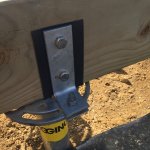ponytug
Super Member
Great to see! Thanks for sharing.
I'm more on the belt and suspenders end of things, and a little added water protection never hurts in my book. I doubt the costs was that high, and if it keeps your inspector on your side, it would be worth every penny in my book.
My folks used screw in pilings in a cottage build on a lake shore that was a peat rich soil. They were closer to three foot diameter screws, down 20-30 feet. The screws went in over about two days with a specialized drilling machine that was large excavator size. My memory is that they were driven to some level of resistance. The concrete foundation was poured on top of them as a "boat", so that if the pilings did sink, the crawl space and one piece concrete floor had enough displacement designed in to prevent the house from sinking more than a few inches, or at least that was the plan. There was some amount of overbuild of the foundation walls to be able to spread the load over long distances in case of a section of failing piles. As long as they lived there, there was no movement.
All the best,
Peter
I'm more on the belt and suspenders end of things, and a little added water protection never hurts in my book. I doubt the costs was that high, and if it keeps your inspector on your side, it would be worth every penny in my book.
My folks used screw in pilings in a cottage build on a lake shore that was a peat rich soil. They were closer to three foot diameter screws, down 20-30 feet. The screws went in over about two days with a specialized drilling machine that was large excavator size. My memory is that they were driven to some level of resistance. The concrete foundation was poured on top of them as a "boat", so that if the pilings did sink, the crawl space and one piece concrete floor had enough displacement designed in to prevent the house from sinking more than a few inches, or at least that was the plan. There was some amount of overbuild of the foundation walls to be able to spread the load over long distances in case of a section of failing piles. As long as they lived there, there was no movement.
All the best,
Peter

